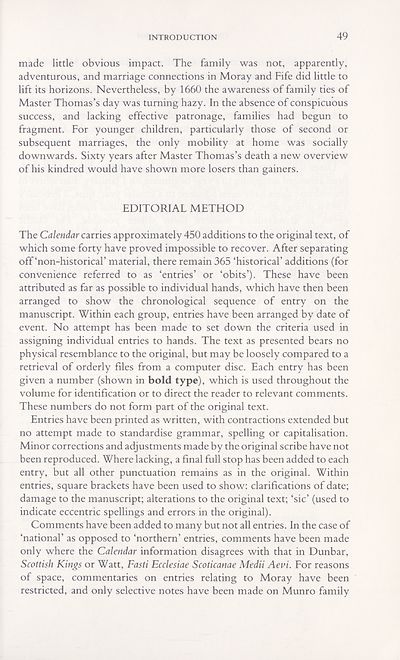Series 5 > Calendar of Fearn
(62) Page 49
Download files
Complete book:
Individual page:
Thumbnail gallery: Grid view | List view

INTRODUCTION
49
made little obvious impact. The family was not, apparently,
adventurous, and marriage connections in Moray and Fife did little to
lift its horizons. Nevertheless, by 1660 the awareness of family ties of
Master Thomas’s day was turning hazy. In the absence of conspicuous
success, and lacking effective patronage, families had begun to
fragment. For younger children, particularly those of second or
subsequent marriages, the only mobility at home was socially
downwards. Sixty years after Master Thomas’s death a new overview
of his kindred would have shown more losers than gainers.
EDITORIAL METHOD
The Calendar carries approximately 450 additions to the original text, of
which some forty have proved impossible to recover. After separating
off‘non-historical’ material, there remain 365 ‘historical’ additions (for
convenience referred to as ‘entries’ or ‘obits’). These have been
attributed as far as possible to individual hands, which have then been
arranged to show the chronological sequence of entry on the
manuscript. Within each group, entries have been arranged by date of
event. No attempt has been made to set down the criteria used in
assigning individual entries to hands. The text as presented bears no
physical resemblance to the original, but may be loosely compared to a
retrieval of orderly files from a computer disc. Each entry has been
given a number (shown in bold type), which is used throughout the
volume for identification or to direct the reader to relevant comments.
These numbers do not form part of the original text.
Entries have been printed as written, with contractions extended but
no attempt made to standardise grammar, spelling or capitalisation.
Minor corrections and adjustments made by the original scribe have not
been reproduced. Where lacking, a final full stop has been added to each
entry, but all other punctuation remains as in the original. Within
entries, square brackets have been used to show: clarifications of date;
damage to the manuscript; alterations to the original text; ‘sic’ (used to
indicate eccentric spellings and errors in the original).
Comments have been added to many but not all entries. In the case of
‘national’ as opposed to ‘northern’ entries, comments have been made
only where the Calendar information disagrees with that in Dunbar,
Scottish Kings or Watt, Fasti Ecclesiae Scoticanae Medii Aevi. For reasons
of space, commentaries on entries relating to Moray have been
restricted, and only selective notes have been made on Munro family
49
made little obvious impact. The family was not, apparently,
adventurous, and marriage connections in Moray and Fife did little to
lift its horizons. Nevertheless, by 1660 the awareness of family ties of
Master Thomas’s day was turning hazy. In the absence of conspicuous
success, and lacking effective patronage, families had begun to
fragment. For younger children, particularly those of second or
subsequent marriages, the only mobility at home was socially
downwards. Sixty years after Master Thomas’s death a new overview
of his kindred would have shown more losers than gainers.
EDITORIAL METHOD
The Calendar carries approximately 450 additions to the original text, of
which some forty have proved impossible to recover. After separating
off‘non-historical’ material, there remain 365 ‘historical’ additions (for
convenience referred to as ‘entries’ or ‘obits’). These have been
attributed as far as possible to individual hands, which have then been
arranged to show the chronological sequence of entry on the
manuscript. Within each group, entries have been arranged by date of
event. No attempt has been made to set down the criteria used in
assigning individual entries to hands. The text as presented bears no
physical resemblance to the original, but may be loosely compared to a
retrieval of orderly files from a computer disc. Each entry has been
given a number (shown in bold type), which is used throughout the
volume for identification or to direct the reader to relevant comments.
These numbers do not form part of the original text.
Entries have been printed as written, with contractions extended but
no attempt made to standardise grammar, spelling or capitalisation.
Minor corrections and adjustments made by the original scribe have not
been reproduced. Where lacking, a final full stop has been added to each
entry, but all other punctuation remains as in the original. Within
entries, square brackets have been used to show: clarifications of date;
damage to the manuscript; alterations to the original text; ‘sic’ (used to
indicate eccentric spellings and errors in the original).
Comments have been added to many but not all entries. In the case of
‘national’ as opposed to ‘northern’ entries, comments have been made
only where the Calendar information disagrees with that in Dunbar,
Scottish Kings or Watt, Fasti Ecclesiae Scoticanae Medii Aevi. For reasons
of space, commentaries on entries relating to Moray have been
restricted, and only selective notes have been made on Munro family
Set display mode to:
![]() Universal Viewer |
Universal Viewer | ![]() Mirador |
Large image | Transcription
Mirador |
Large image | Transcription
Images and transcriptions on this page, including medium image downloads, may be used under the Creative Commons Attribution 4.0 International Licence unless otherwise stated. ![]()
| Scottish History Society volumes > Series 5 > Calendar of Fearn > (62) Page 49 |
|---|
| Permanent URL | https://digital.nls.uk/127351893 |
|---|
| Description | Over 180 volumes, published by the Scottish History Society, containing original sources on Scotland's history and people. With a wide range of subjects, the books collectively cover all periods from the 12th to 20th centuries, and reflect changing trends in Scottish history. Sources are accompanied by scholarly interpretation, references and bibliographies. Volumes are usually published annually, and more digitised volumes will be added as they become available. |
|---|


